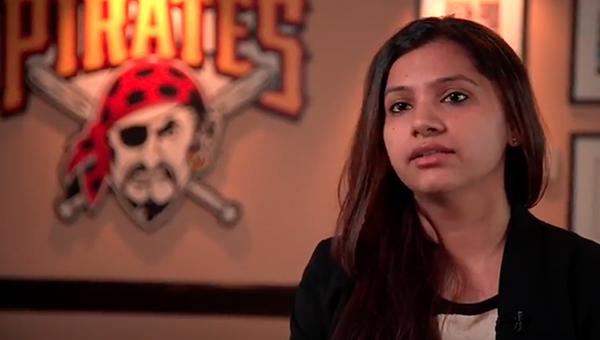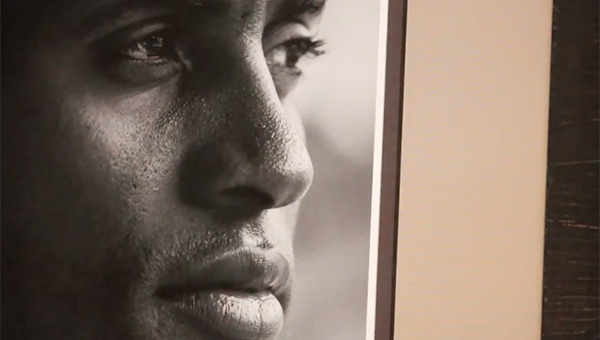From College to the Pros: Heinz College Students Innovate for Local Sports Teams
By Michael Cunningham
In recent years, Heinz College students have utilized their skills in analytics, research, and management to develop innovative solutions to off-the-field challenges that face Pittsburgh’s professional sports organizations and their affiliated institutions—all while adding a little black and gold to their wardrobes in the process.
In 2015, The New York Times declared Pittsburgh the second most successful sports city in the United States, based on its major sports teams winning championships in eight percent of the seasons in which they’ve played over the last 50 years. And that was before the Pittsburgh Penguins took home back-to-back Stanley Cups in 2016 and 2017, earning and then defending the most coveted prize in professional hockey.
That championship success has fostered a special love affair between Pittsburgh’s sports teams and their devoted fans, who wear their hearts on their black and gold sleeves and pack local stadiums for home games. The Pittsburgh Steelers, who play in 65,000-seat Heinz Field, have sold out every home game dating back to November of 1972. And the Stanley Cup Champion Penguins have not played to an empty seat since the PPG Paints Arena opened its doors for the first time in August of 2010.
Falling in love with Pittsburgh’s sports teams can be infectious, especially for Carnegie Mellon University students, who can take advantage of special student discounts on tickets to catch all of the action on the gridiron, the ice, or the baseball diamond. But for Heinz College students, their relationship with local sports franchises often evolves past fandom to professional collaboration.
Raising the (Social Analytics) Jolly Roger
As a legendary baseball club, the Pittsburgh Pirates franchise has five World Series titles and nine National League pennants to its name. But when it came time for the Pirates to find new ways to leverage their social media interactions with their fans, they turned to Carnegie Mellon students for innovative solutions.
“We’ve got almost a million Facebook followers and half-a-million Twitter followers,” said Jim Alexander, the Pirates’ senior director of Business Analytics. “The challenge is that we’re trying to measure the impact that we’re having.
“We thought this was the perfect time for us to use the brainpower that CMU brings.”
That brainpower came in the form of Heinz College’s Measuring Social class, where students study the impact of social media and content on website traffic and user experiences. Since interdisciplinary collaboration is one of Carnegie Mellon University’s strengths, the class is open to students from all over campus, which leads to a unique blending of knowledge and experience.
“We have folks who have expertise in security policy and management, public policy and management, information systems and management, as well as business students,” said Ari Lightman, Heinz College professor and Measuring Social course instructor. “So they all bring a different skill set and a different thought process.
“Different skill sets are great because you really see a rise in terms of innovation.”
The project involved finding new ways for the Pirates to better serve the fans with whom they engage on social media. The Measuring Social team developed an algorithm that would help the Pirates organization better determine which variables will lead to more engagement on social media platforms. Increased engagement on social media leads to a direct increase in fan loyalty and revenue.
“We got a better understanding from the fans themselves of what they wanted from the Pirates social media,” said Therese M. Joseph, a Master of Arts in Professional Writing student. “Being able to have that kind of specific data and share that with the Pirates is invaluable.”
“I think any time you work in a real-world setting, it prepares you for the future,” said Marco Loffreda-Mancinelli, a Master of Science in Information Security Policy and Management (MSISPM) student at Heinz.
“That’s what I think is the best part of these kinds of projects. You get to work with people who see you as peers, not as students.”
For the Pirates, who now boast their own Social Media Clubhouse, the algorithm provided by the CMU students has been a valuable instrument in improving meaningful fan engagement, impacting everything from in-game promotions to All-Star game voting.
“I think it’s a wonderful partnership, and the CMU students bring credibility to the table immediately,” added Alexander. “They’re great people and great teams to work with. “Hopefully we can do it for many years to come.”
Helping the Pens Give Back to their Fans
When the Pittsburgh Penguins opened the PPG Paints Arena in 2010, the organization wanted to develop new ways to thank fans for their loyalty to the franchise—loyalty that helped generate the revenue to build the arena in the first place. The Pens hoped to establish a reward-based digital loyalty program, which would strengthen the fan experience, increase revenue for the team, and gather new and valuable data for the franchise.
So the Pens partnered with a group of Heinz College Master of Information Systems Management (MISM) students to not only do the marketing and IT research necessary to create such a program, but to build its software from the ground up.
“Loyalty programs allow the host to better track member behaviors by keeping track of when, where and how much they buy as well as who they are and where they’re from,” the students wrote in their client report. “This element of loyalty programs will allow the Penguins moving forward to produce new and previously unachievable information, which they can then use to market their products more effectively.”
The students began by researching best practices across loyalty programs for similar industries, including the 18 National Hockey League franchises that employed some form of loyalty program at the time, and other regional athletic organizations like the Pittsburgh Steelers and the Pitt Panthers athletic department. The student team then researched the Penguins’ IT infrastructure, developing strategies for integrating the team’s current infrastructure in the soon-to-be-written loyalty program management system in the process.
Upon completing the research phase of their project, the MISM team compiled a recommendation for the loyalty program.
“This recommendation was based on a combination of the research, fan focus groups, fan surveys and discussions with the client,” the students explained. “The recommendation contains information on both possible rewardable actions and a rewards tree. The points associated with those rewards are scaled in such a way that users with multiple seats to their names do not have an advantage in earning rewards.”
With all of the research and recommendations completed and in hand, the student team set forth to develop a software system entitled Power Play Points. The students used a combination of Java, Play!, and MySQL to create a comprehensive Web application to house the loyalty program.
“Power Play Points is a customer loyalty program designed to reward season ticket holders for their dedication to the team through attendance and in-arena purchases,” the students explained. “The current version of the system allows users to earn points through various actions and then redeem them online.”
The MISM-designed Power Play Points system laid the groundwork for PensPoints, a popular smartphone app that the Penguins currently use to track and reward fan activity, such as attending games, making purchases at merchandise and concessions stands, and watching and listening to game broadcasts. Fans can earn points by participating in different activities, then redeem those points for rewards ranging from autographed jerseys and gift cards to unique fan experiences.
The hard work, creativity, and innovative research that the MISM students displayed in developing the Power Play Points software application has paid dividends for the Penguins franchise. In ESPN the Magazine’s 2015 “Ultimate Standings,” which ranks all 122 professional sports franchises across the four major American pro sports leagues in a variety of categories, the Penguins ranked fifth among NHL teams and 13th overall in the category of “Fan Relations.”
Developing the North Shore
In 1998, the Sports and Exhibition Authority of Pittsburgh began financial planning to build two new stadiums on Pittsburgh’s North Shore. The stadiums—Heinz Field for the Steelers and PNC Park for the Pirates—were completed in 2001. And as part of the agreement with the City and the Stadium Authority, the Pirates and Steelers were under legal obligation to develop the land in the area between the two stadiums with specific guidelines, and on a specific timeline.
So in 2014, the Steelers partnered with a group of Master of Public Management (MPM) students to conduct a residential market analysis to determine the outlook for a potential residential community located between the two stadiums. The students conducted an analysis of both the local and the national market, including residential supply an demand studies for the North Shore, as well as a benchmarking analysis that compared the North Shore to residential areas around other NFL stadiums in Cincinnati, St. Louis, and Charlotte.
“Our goal was to provide insight as to what infrastructure and amenity needs will be associated with such a project,” the students wrote.
The students informed the Steelers that there was a definite interest in an upscale apartment complex located at the North Shore. Through their research, the student team found that demand far exceeded supply for upscale rentals, and that the North Shore was the next natural destination for living in the downtown area, due to the projected population growth in the city and the increased shift from owning to renting.
“There is no where else in the city that combines downtown living with access to both the rivers and mass transit within steps of your front door,” the students reported. “Not only are both the bus and rail available, but there’s sufficient parking supply to support residential as compared to other downtown living options.
“The face of downtown living is changing and the North Shore should be its destination.”

PNC Park, home of the Pittsburgh Pirates, is consistently ranked as one of the best—if not the best—stadiums in Major League Baseball
---
Honoring Number 21
When Pittsburgh Pirates outfielder Roberto Clemente died in a plane crash on December 31, 1972, en route to delivering supplies to earthquake victims in Nicaragua, he left behind the legacy of a tireless humanitarian, a staunch civil rights activist who paved the way for Latin American ballplayers in the 1950s and ‘60s, and one of baseball’s all-time great players.
As a kid growing up in Pittsburgh, Duane Rieder idolized Clemente, collecting his baseball cards and other Clemente-related memorabilia. And since 2006, Rieder, a commercial photographer, has operated the Roberto Clemente Museum out of Engine House 25 in Pittsburgh’s Lawrenceville neighborhood, an old firehouse that also houses Rieder’s photography studio and winemaking business. The museum features singular artifacts on loan from the Clemente family, historic documents, and a bevy of photographs, many of which Rieder printed himself from negatives rescued from newspaper dumpsters and estate sales.
With a full-time staff of two, the museum has traditionally offered private tours by appointment only, and recently began opening up the building for a quarterly open house. But in order to survive as a privately owned nonprofit museum in the Pittsburgh market, Rieder knew that the Clemente Museum needed to scale up. So he collaborated with a group of Carnegie Mellon Master of Arts Management (MAM) students, who he hoped could identify opportunities to strengthen its position in the local market and expand its offerings.
“There were a couple of real baseball nuts in that group, and when we saw the students get excited, we knew that it wouldn’t be a boring project for them,” Rieder said. “We’re so busy here and our staff is small, we don’t have time to go do all of that research. The information that they handed over to us was priceless, and there’s no way we could ever do that on our own.”
To accomplish their research goals, the MAM students analyzed the access, curatorial intent, and organizational structure of the Clemente Museum. They first conducted an environmental scan, analyzing internal operational factors and external cultural factors, to define the museum’s place within the Pittsburgh market and highlight its opportunities for improvement.
“My primary contribution to this project was looking at some of the numbers – looking at the statistics and the economics of how the Roberto Clemente Museum fits within the Pittsburgh region,” said Daniel Fonner, a MAM alumnus and current Fulbright scholar in Coventry, England. “A lot of times people look at the arts and separate them from math and the sciences as different entities. But I think to develop strong arts organizations, it’s critical that you utilize math and science to analyze these organizations’ finances and create conclusions to help them reach their fullest potential.”
The student team then researched best practices of comparable organizations from throughout the U.S. by benchmarking a control group of similar sports museums from around the country and developing case studies based on exemplary museums in the field.
“We did a lot of research looking at small, single-athlete museums,” said Sarah Bloethe, a MAM alumna who worked on the project. “It was really fascinating to see the different kinds of organizations and what exactly they do. I did not know how vast and varied the field of sports museums was, and it was an incredibly eye-opening experience.”
Based on their research, the student team made a series of recommendations to Rieder and his staff, including establishing standing hours, developing traveling exhibits and educational outreach programs, and establishing partnerships with other affiliated organizations to maintain operation and maximize sustainability.
Most importantly, the MAM students presented Rieder with a “best-practices toolkit” to help the museum implement data-driven strategies in its operations and pricing structure.
“We’re very pleased with all of the work that they did, and we’re really going to dive into the toolkit and start implementing some of these things at the museum immediately,” Rieder said. “The students were unbelievable, and I would work with Heinz students every semester if we wouldn’t be taking advantage of them! They’re really going to help the museum move forward.”
For the students themselves, having an opportunity to work with a small organization enables them to experience the tangible outcomes of their research firsthand.
“I’ve worked for large organizations, and I also have experience at very small organizations, which the Roberto Clemente Museum is,” said Jesse Albright, one of the student team members. “And through those experiences, I’ve seen that these smaller organizations really do need the help. They have a lack of resources. They may have all the drive in the world and a fantastic mission, but getting things done on a day-to-day basis is difficult. They don’t have the same support systems that a large institution has naturally. So being able to empower them to take it to the next level and to be effective, doing a project for them, you really see an impact.”
Learn more about the MISM Program

